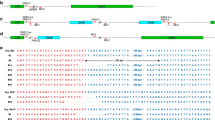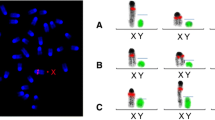Abstract
We found a new X-linked dominant mouse mutation. This mouse has the same phenotype as Td, which exhibits hyperkeratotic skin, reduced viability in affected females, a tendency to be smaller, lighter weight than the normal sibs during weaning age, and prenatal lethality in affected males. To map the locus, we tested 267 progeny from an intraspecific backcross between affected females and wild-origin strain males. Polymerase chain reaction (PCR) was performed with microsatellite markers of the proximal region of the mouse X Chromosome (Chr). This mutant showed no recombination with DXMit 123, DXMit 55, or DXMit 26. The gene position and phenotype of this mutant were very similar to those of Td. Therefore, it is speculated that the new mutant gene is a multiple allele of Td, and we designated it Tattered-Hokkaido (Td ho). Linkage analysis of these animals suggested a possible gene order of cen-(Td ho, DXMit123, DXMit55, DXMit26)-DXMit161-DXMit54-DXMitI03-DXMit52-DXMitI90-DXMit138) in the X Chr. Prenatal lethality of male mutants was also investigated, with 12.5 to 16.5 embryonic day (E) backcrossed embryos from affected F1 females. It was found that the male mutants died between E12.5 and E14.5. The cause of death of male mutants is discussed in relation with the other proximal genes of the X Chr.
Similar content being viewed by others
References
Beckmann H, Su L, Kadesch T (1990) TFE3: A helix-loop-helix protein that activates transcription through the immunoglobulin enhancer μE3 motif. Genes Dev 4, 167–179
Blair PJ, Carpenter DA, Godfrey VL, Russell LB, Wilkinson JE, Rinchik EM (1994) The mouse scurfy (sf) mutation is tightly linked to Gata1 and Tfe3 on the proximal X Chromosome. Mamm Genome 5, 652–654
Brotherton TW, Chui DHK, Gauldie J, Patterson M (1979) Hemoglobin ontogeny during normal mouse fetal development. Proc Natl Acad Sci USA 76, 2853–2857
Calligaris R, Bottardi S, Cogoi S, Apezteguia I, Santoro C (1995) Alternative translation initiation site usage results in two functionally distinct forms of the GATA-1 transcription factor. Proc Natl Acad Sci USA 92, 11598–11602
Cattanach (1982a) A new X-linked mutation. Mouse News Lett 66, 61–62
Cattanach (1982b) Location of tattered (Td). Mouse News Lett 67, 19
Derry JMJ, Ochs HD, Francke U (1994) Isolation of a novel gene mutated in Wiskott-Aldrich syndrome. Cell 78, 635–644
Derry JMJ, Wiedemann P, Blair P, Wang Y, Kerns JA, Lemahieu V, Godfrey VL, Wilkinson JE, Francke U (1995) The mouse homolog of the Wiskott-Aldrich syndrome protein (WASP) gene is highly conserved and maps near the scurfy (sf) mutation on the X chromosome. Genomics 29, 471–477
Herman GE, Blair HJ, Boyd Y, Brown SDM, de Gouyon B, Haynes A, Quaderi N (1996) Mouse X chromosome. Mamm Genome 6 (Suppl), S317-S330
Kunieda T, Xian M, Kobayashi E, Imamichi T, Moriwaki K, Toyoda Y (1992) Sexing of mouse preimplantation embryos by detection of Y chromosome-specific sequences using polymerase chain reaction. Biol Reprod 46, 692–697
Martin DIK, Zon LI, Mutter G, Orkin SH (1990) Expression of an erythroid transcription factor in megakaryocytic and mast cell lineages. Nature 344, 444–447
Merrell K, Gonzales JC, Wells S, Calame K, Herman GE (1995) Genetic analyses of tattered, an X-linked dominant, developmental mouse mutation. Mamm Genome 6, 291–294
Pevny L, Simon MC, Robertson E, Klein WH, Tsai S, D’Agati V, Orkin SH, Costantini F (1991) Erythroid differentiation in chimaeric mice blocked by a targeted mutation in the gene for transcription factor GATA-1. Nature 349, 257–260
Rugh R, (1990) Blood of the mouse fetus. In The Mouse: Its Reproduction and Development (Frome, Somerset: Butler and Tanner Ltd), p 272
Weiss MJ, Keller G, Orkin SH (1994) Novel insights into erythroid development revealed through in vitro differentiation of GATA-1 embryonic stem cells. Genes Dev 8, 1184–1197
Author information
Authors and Affiliations
Rights and permissions
About this article
Cite this article
Seo, K.W., Miyoshi, H., Kon, Y. et al. Chromosomal mapping and developmental study of tattered-hokkaido (Td ho). Mammalian Genome 8, 578–580 (1997). https://doi.org/10.1007/s003359900507
Received:
Issue Date:
DOI: https://doi.org/10.1007/s003359900507




